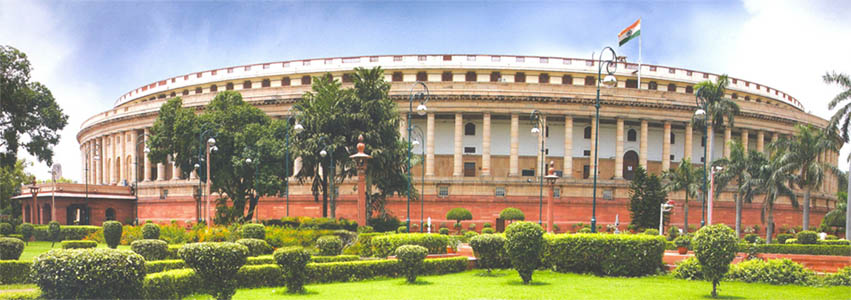Kingshuk Sarkar
 Photo Credit: Reuters
Photo Credit: Reuters
Ministry of Labour & Employment, Govt. of India has amalgamated all the existing social security legislations into a Code. The proposed draft Code on Social Security is presently being referred to Parliamentary Standing Committee on Labour for examination. This commentary highlights the salient features of the proposed code and discusses the areas of improvement and concerns.
.
After considerable period of deliberations and consultations, the union government has circulated the draft social security code, a key labour law proposal that seeks to amalgamate a clutch of existing laws. The Code on Social Security, 2019 once in place will merge eight exiting labour laws including Employees’ Compensation Act, 1923; Employees’ State Insurance Act, 1948, Employees‘ Provident Funds and Miscellaneous Provisions Act, 1952; Maternity Benefit Act, 1961; Payment of Gratuity Act, 1972; Cine Workers Welfare Fund Act, 1981; Building and Other Construction Workers Cess Act, 1996 and Unorganized Workers‘ Social Security Act, 2008. The Code proposes few new initiatives like social security for unorganized sector workers and insurance and health benefits for gig workers. Besides, it also proposes corporatization of existing organizations like EPFO and ESIC to be headed by people other than the labour minister. Here are the few key things in the draft code:
.
1) Insurance, PF, life cover for unorganized sector employees:
The draft code says the “Central Government shall formulate and notify, from time to time, suitable welfare schemes for unorganised workers on matter relating to life and disability cover; health and maternity benefits; old age protection; and any other benefit as may be determined by the central government”.
While framing of schemes, the draft says the states may also formulate and notify suitable initiatives for unorganized workers, including schemes relating to provident fund, employment injury benefit, housing, educational scheme for their children, old age and funeral assistance.
In this context, it can be said that a major part (93 per cent) of India’s labour force is in unorganized sector. About half of unorganized sector workers are self-employed where it would be very difficult to decipher any sort of employer-employee relationship. Most of the unorganized sector workers are not attached to any specific occupation. Rather they shift from one form occupation to another based on availability and moreover unorganized sector workers are footloose in the sense they keep on moving from place to another in search of livelihood. Most of the unorganized sector workers fall within the State purview rather than Centre purview. In fact, it would be difficult to even define appropriate government for the unorganized sector workers since they are mostly employed through layers of intermediaries. There may be unorganized sector social security boards at the Centre and State levels but major part of the organization seems to be with States. The scope of the Central Board seems very limited but the State Boards have serious constraints with regards to financial resources compared to task at hand. Also as unorganized sector workers spread across the entire length and breadth of the country, inter-state arrangement and cooperation becomes all the more imperative. The Code does not provide for such eventualities. Ideally, centre should conceptualize a basic structure which if successful should be adopted by states after necessary customization. Without such basic structure, implications of this Code would be too varied across States to be administered.
Also, the issue of providing holistic social security cover for the entire unorganized sector workforce in a simple effective manner is something which is lost in the center-state labyrinth and jurisdictional, institutional overlapping. Unorganized sector workforce is all encompassing minus the minuscule regular worker of organized sectors. This identity should be primal and all unorganized sector workers should have access to basic social security coverage irrespective of labour market classifications. Such inclusion in an easy meaningful way is something which is missing in the Code. The concept of universal social security for all is a concept which is missing and had been dealt with bits and pieces manner in the Code.
.
2) Corporatization of EPFO and ESIC:
The pension, insurance and retirement saving bodies including EPFO and ESIC will be body corporate. The word body corporate has been added in the draft and this is qualitatively different from the present definition. The draft also talks about appointment of chief executive officers (CEOs) in these organization indicating that the labour minister, labour secretary, the central PF commissioner and Director General of ESIC may not be by default the head of such organizations.
.
It means, the EPFO may become a more structured national body with its entire Rs. 11 trillion corpus under the responsibility of a central government-appointed chairperson. Currently EPFO is headed by the labour minister who is also the chairperson of central board of trustees. “The Central Government shall also appoint a Financial Advisor and Chief Accounts Officer to assist the Chief Executive Officer in the discharge of his duties,” draft code said. “The Central Board shall be a body corporate, having perpetual succession…”.
.
Corporatization of EPFO, ESIC as indicated in the Code would bring element of uncertainty in the portfolio management. ESIC and EPFO together has the custody of huge sum of money meant for a sizable section of the workforce. This money belongs to the registered workers themselves and leaving the custody outside governmental control seems a bit risky given the records of corporate fund management in recent years.
.
3) Benefits for Gig workers:
The Code extends social security provisions for the gig and platform workers too. As per the draft social security code, the “Central Government may formulate and notify, from time to time, suitable social security schemes for gig workers and platform workers” and such schemes would encompass issues like “life and disability cover”, “health and maternity benefits”, “old age protection” and “any other benefit as may be determined by the Central Government”.
.
Though the exact number of gig workers are unknown as they are still figuring out whether they are formal workers or unorganized workers or independent entrepreneurs, a 2017 study by consulting firm EY has said that nearly one out four gig workers in the world are from India. The draft proposal comes as State of California in US approved a law for wage benefit and protection for gig workers such as those working in taxi aggregating companies like Uber and Lyft. Like Ola in India, Lyft is a popular taxi aggregator in the US.
.
Inclusion of gig or platform workers within the Code is an innovative approach keeping in pace with the changing world of work. This should remain open because new forms of labour emerge with changes in technology. General terms like gig or platform workers are appropriate because it will absorb a whole range of people within its fold. Future of work entails that there would be further mystification of employer-employee relation using digital technology. Workers would seem independent and self-employed in such a context and provision of social security would remain inadequate or even non-existent. Code does take this aspect into account to a certain extent.
.
Other acts like maternity benefit act, payment of gratuity act, employee’s compensation act, building and construction workers cess act all have their basic provisions remaining same but each has been incorporated as Chapters in the Code. It is like clubbing provisions of existing acts into a code without any major tinkering. Hitherto acts now become chapters. This is simplification to a certain extent. However, it seems an opportunity is lost in the sense that these elements of social security could have been interwoven into a holistic social security legislation. Code in present form appears like collection of existing legislations without that thread of meaningful integration.
.
Trade unions have already stated that they were against the proposal for provident fund, pension and insurance funds to be administered by a central board. In fact, they are against the corporatization of these boards. Recently, a prominent national trade union said it had rejected the draft code in its comments submitted to the Ministry. The trade union said in a statement that the first draft had provisions for the right to social security for all and establishment of a central apex council, headed by the Prime Minister, but these were missing from the latest draft.
.
To sum up, the draft social security code is an amalgamation of existing legislations. Universalization of social security across sectors as a legislative right have not been explicitly incorporated. Hints are there but it skirted the matter tangentially and trivializes the existing provisions. Suggestions of corporatization of social security funds is regressive given the present state of being. The fact that provision of social security could have used towards formalization of workforce to a certain extent, is something which is disappointingly missing in the Code. Employers should be made to own up the fact they have responsibility in providing social security to their workers. State has a responsibility but the primary responsibility still lies with employers since they are taking advantage of workers’ productivity. State can provide the basic eco-system but labour market relation should prevail in specific micro context. Financial constraints are there on the part of state too. Code did not go into those terrains. At the end this Code remained a collage of existing legislations without that interweaving thread of integration. It provided hints of progression but stopped well short of attaining those aspirations. It promised but could not meet those expectations.
.
The author is Independent Researcher and Joint Labour Commissioner, Govt. of West Bengal. Can be contacted at kingshuk71@hotmail.com
.
References:


